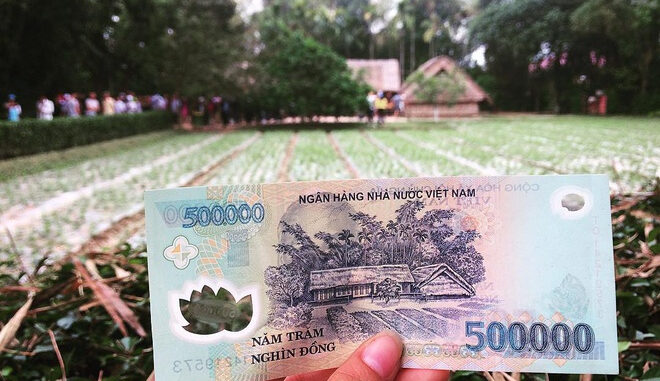
Money is something that people use every day, imagine how chaotic life would be without money. Although touching hands every day, few people often “notice” the motifs and places other than the numbers printed on the money. Currency is not only an equivalent object, a payment unit of each country, but through each banknote, it shows the culture of the country, each place printed on the banknote represents strength, knowledge, and understanding. the ancient architecture of the country. The following Vinlove will take you to travel around the beautiful country of Vietnam through the landmarks printed on the banknote.
Pho Minh Pagoda (100 dong note)
On the back of the 100 VND note, which is no longer issued and circulated, there is a picture of the Pho Minh Pagoda and tower. However, not everyone knows about this place on the coin. Located in Loc Vuong ward, Nam Dinh city, Nam Dinh province, Pho Minh pagoda or Thap pagoda is one of the important vestiges remaining of a time of the Tran Dynasty. According to the chronicle, the pagoda was built in 1262, in the west of Trung Quang Palace of the Tran kings. But according to the epitaph, the pagoda has existed since the Ly dynasty and was rebuilt on a large scale in 1262. Although it has been restored many times, the pagoda still retains many architectural vestiges of the Tran dynasty. The main architectural cluster of Pho Minh pagoda including 9 front halls, 3 incense burning compartments, the upper hall also 3 compartments but larger, arranged in the shape of the word “public”.
Behind the upper hall, away from a narrow yard is an 11-room longhouse. In the middle are 5 compartments of the ancestral house, on the left are 3 compartments of the monk’s house and on the right are 3 compartments of the shrine. Two rows of corridors connect the front street with the 11-room house in the back, forming a square frame surrounding the temple architecture. Besides the Buddhas and Bodhisattvas, the pagoda also worships the ancestors of the Truc Lam Yen Tu Zen sect, including To Tran Nhan Tong, To Phap Loa, and the statue of Huyen Quang. Pho Minh Pagoda is the opening place for the Buddhist architecture of the Tran Dynasty. The architectural works and carvings here still retain the imprints of the Tran and Mac dynasties such as ironwood doors, Pho Minh tower, double crocodiles in the three gates, dragons in the front steps, towers, and statues. Princess Mac,… The most important Tran Dynasty architecture that is still preserved quite intact of the pagoda is Pho Minh tower, located in front of the street.
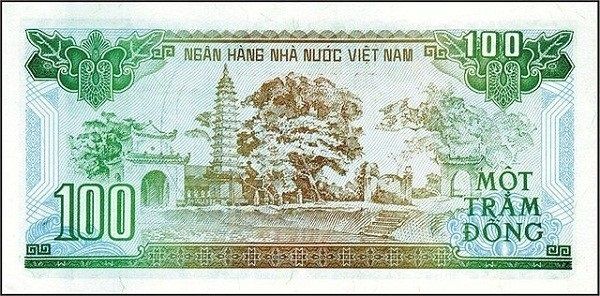
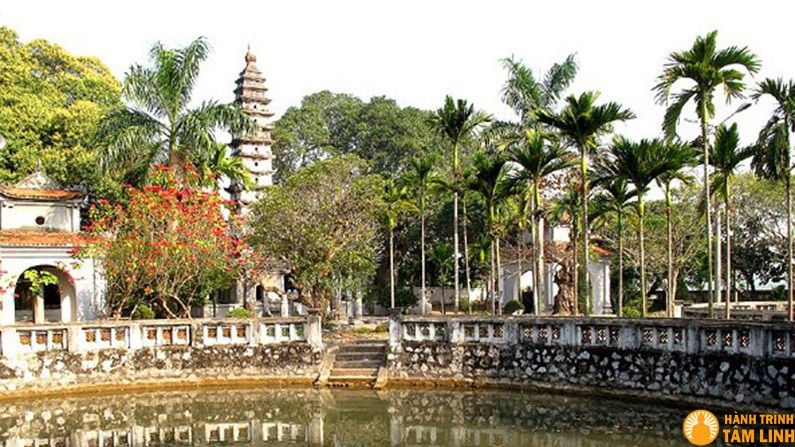
Hai Phong Port (VND 500 note)
The 500 (five hundred) dong, the Vietnamese currency, currently in circulation, is the smallest denomination in the monetary system, issued on August 15, 1989 (number printed on popular currencies). variable is 1988 is the year of manufacture). On the back of the eye-catching red 500 dong bill is the image of Hai Phong port . Although many people may know that Hai Phong port is the second largest seaport in our country, few people may recognize it when looking at the picture. Hai Phong Port was built by the French in 1874 and was used for landing and resupplying expeditionary troops. Later, this trading port was connected to Yunnan, China by train. In the North, no one is unaware of Hai Phong port, especially those who trade and transport goods by sea, must definitely dock at this seaport.
Hai Phong port is the second largest seaport cluster in our country, only after Saigon port. Hai Phong port is located between two districts of Hong Bang and Ngo Quyen of the city of red phoenix flowers. Built in 1874 by French architects. Initially, the port was built with the purpose of reinforcing troops for the French military. However, later through the development process, the port expanded and became an important trading port connecting China’s Yunnan for convenient traffic. Formed in 1876, after more than 142 years of development, the port is considered an important border gate for goods exchange, import and export of the country.
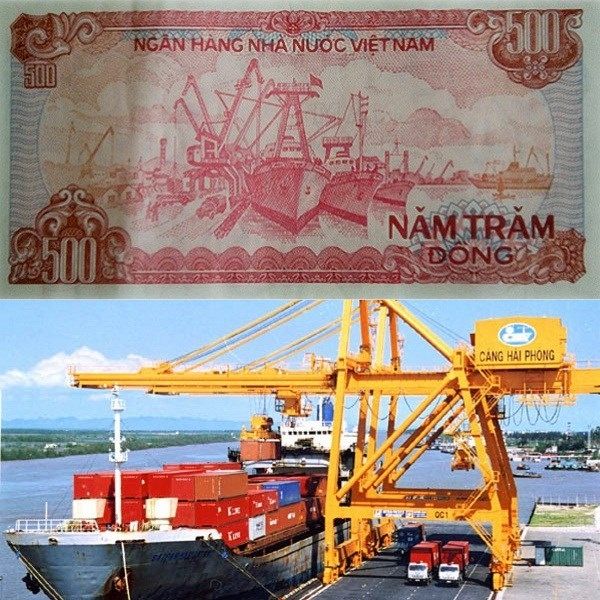

Central Highlands (VND 1,000 bill)
Elephants represent the strength, beliefs and culture of the Central Highlands people in general and the people of Ban Don in particular. That’s why the image of the Ban Don elephant was put on the 1,000-sided banknote by the Republic of Vietnam after 1972 and in the Socialist Republic of Vietnam’s 1,000-note in 1988. The back of the 1,000-dong bill is printed with an elephant pulling wood. This is a very typical image of the lands west Nguyen. This banknote is a picture of laborers riding elephants, logging in the Central Highlands . This coin is still widely circulated in the market today. Released on October 20, 1989. The Central Highlands with basalt red soil is very suitable for growing industrial crops such as pepper, coffee, cocoa… At the same time, the Central HighlandsIt is also an area with a lot of forest area with diverse biota, rich mineral reserves and great tourism potential.
Ban Don is considered the place where the elephant kingdom in Dak Lak province is home to the largest herd of wild and domestic elephants in Vietnam with the number of about 80-110 wild elephants and 61 domestic elephants. Herds of wild elephants and domestic elephants are decreasing in number and facing the risk of becoming only a legend. Hunting and taming wild elephants in Ban Don. Accompanying the raising of domestic elephants is a system of beliefs and cultural activities related to elephants, forming a cultural “line” about elephants. But the continuous deforestation here is making the area shrinking, the invasion of each group of migrants, the presence of machinery in the forest causing noise also makes the elephants old and weak. more and more degraded over time.
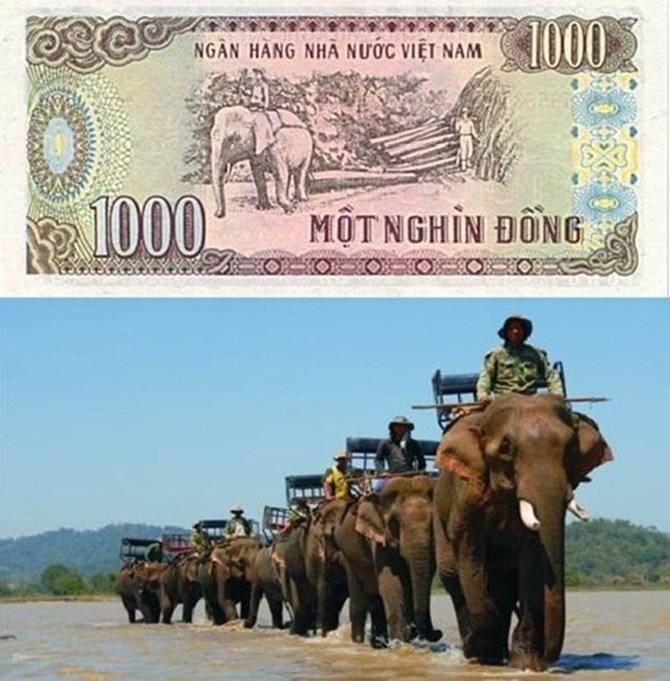
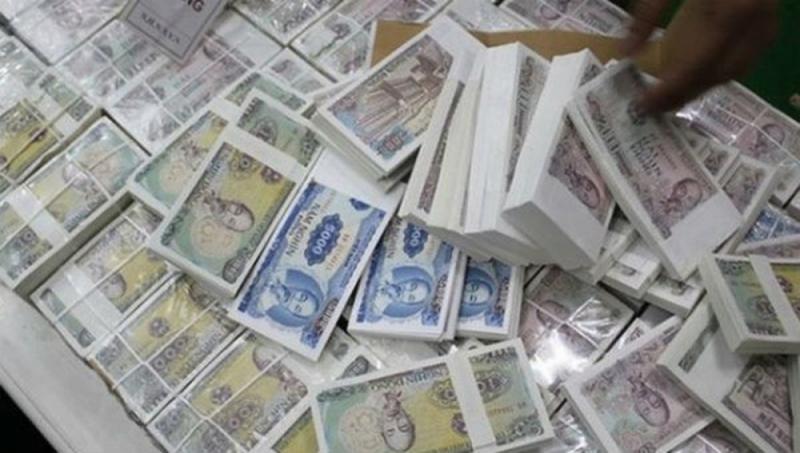
Nam Dinh Textile Factory (VND 2,000 bill)
We spend this small denomination note every day, but who among us often wonders what is so special about this textile factory image to be printed on this national currency? On the back of the 2,000 note is a female image. Workers are working at Nam Dinh textile factory. At that time, the Nam Dinh textile factory was considered the largest factory in Indochina. During the years of resistance against the US, Nam Dinh textile factory was a great bright spot in terms of solidarity, unyielding and indomitable will to fight. Not only good at fighting the enemy, but also increasing production, being a strong rear to supply Viet Minh troops. The textile factory became the premise for the revolutionary movement of the working class to grow stronger.
In particular, the command area of the textile factory is the command headquarters, the headquarter for intelligence and communication activities of the whole textile factory during the years of resistance against the US imperialists. Currently, the command area has been destroyed a lot and only a small part remains in Cua Bac ward of Nam Dinh city. Nam Dinh Textile Complex is a proud symbol of Nam Dinh City, making it even known as the Textile City. This factory is known as the largest factory in Indochina. In 1924, the number of factory workers increased to 6,000 people and nearly 13,000 employees in 1985. At the time in 1985, it was estimated that one person in each family in Nam Thanh was an average person. factory workers.
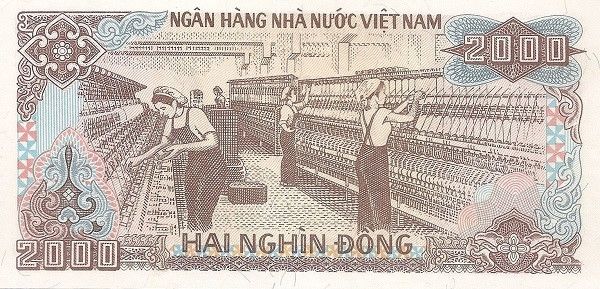
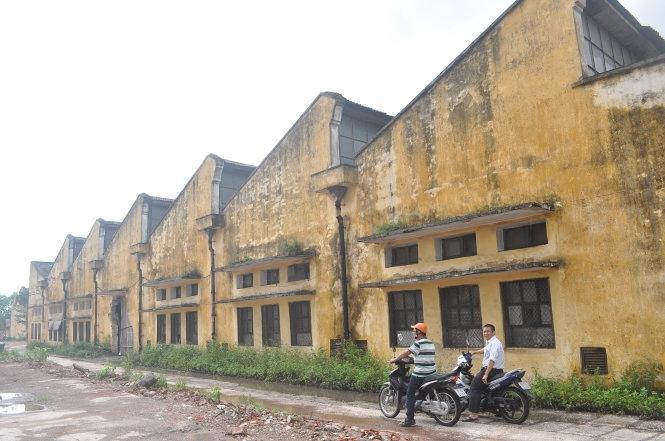
Tri An Hydropower Plant (VND 5,000 bill)
On the back of the 5,000 dong note is an image of the Tri An hydroelectric plant. This factory is located in Tri An lake, in Dong Nai province. It was built by Soviet investment in 1984 and went into operation in 1991. Tri An hydroelectric power plant provides about 1.7 billion KWh annually for the whole country. Tri An Lake is an artificial lake located on the Dong Nai River to store water from the river and is the source of water for the Tri An hydropower plant. Tri An Reservoir is an annual regulating reservoir, the purpose of which is to generate electricity with normal water level rise (HBT) 62 m, dead water level (HC) 50 m, reinforced water level 63.9 m. The running flow at rated capacity is 880 m3/s, equivalent to 220 m3/s for each unit, the water column is 53m. The hydropower plant was built with a total installed capacity of 4 units × 100 MW = 400 MW, annual electricity output of 1.76 billion kWh.
The main pressure route consists of a dam and a spillway. The dam is made of mixed soil and rock, 420m long, 40m high, 10m wide at the top. The overflow dam is 150m long, has 8 overflow chambers, each 15m wide with 8 valve gates which are opened and closed by a 2×125 ton goat foot crane. The main dam and its auxiliary dams make up a 323 km2 reservoir with a total capacity of 2.76 billion m3, the useful capacity of 2.54 billion m3, dead volume of 0.218,109 m3. Tri An hydropower project also has general economic significance with the main purpose of connecting to the national power grid with other plants to supply electricity for national loads. In addition, as a multi-purpose hydroelectric power plant, the project also ensures water for domestic use, agriculture, saline intrusion and flood control. This is also an ideal destination for young people who want to explore beautiful nature,
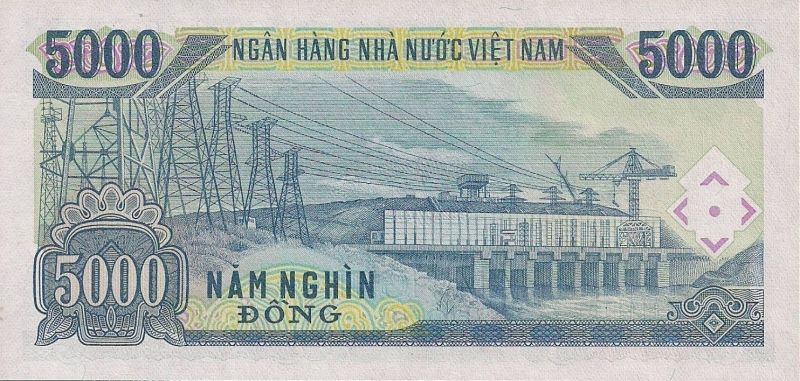
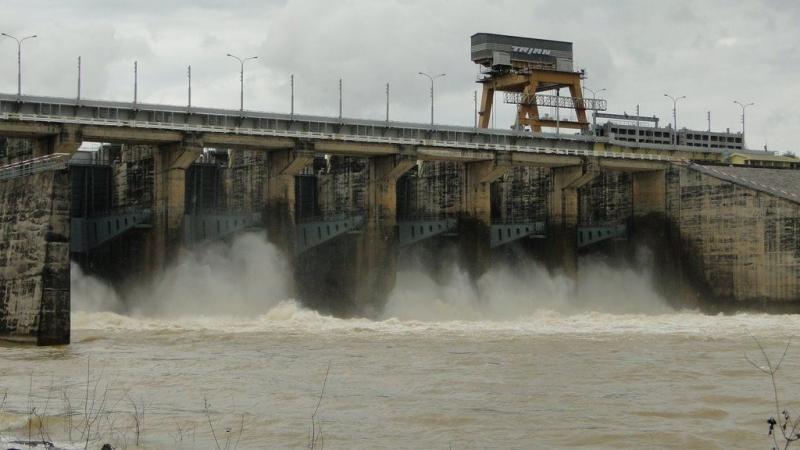
Bach Ho oil field (VND 10,000 bill)
Bach Ho is the name of an oil field being exploited in Vietnam in the Cuu Long basin. The mine is located in the southeast, about 145 km from the coast of Vung Tau. This is the main oil supply field for Vietnam today. This mining unit is the Vietnam-Soviet Petroleum Joint Venture Enterprise under the Vietnam National Oil and Gas Group. From this field, there is an associated gas pipeline to the shore supplying Dinh Co Liquefied Gas Plant, Ba Ria Power Plant and Phu My Power Center, 40 km from Vung Tau. White Tiger Mine currently exploiting by self-spraying mode, making a significant contribution to the national economy. This is the main oil supply field for Vietnam today. The unit exploiting Bach Ho oil field is the Vietnam – Soviet Petroleum Joint Venture Enterprise under the Vietnam National Oil and Gas Group. From this field, there is an associated gas pipeline to the mainland to supply Dinh Co liquefied gas plant, Ba Ria power plant and Phu My Power Center, 40 km from Vung Tau.
On the back of the 10,000 dong note is the image of Bach Ho oil field . This oil field belongs to the Cuu Long basin, about 145 km from the coast of Vung Tau. “Bach Ho” is recognized as the largest oil field in Vietnam, one of the special fields in the world with extremely large reserves, over 500 million tons of oil and gas reserves in place, organized by Vietsovpetro with exploitation by Vietsovpetro. high production, about 12 million tons/year, from the aquifer is Mesozoic granitoid basement rock in Tertiary sedimentary basins. Bach Ho field with the oil body in the cracked granitoid foundation – a cave with large reserves and output, high exploitation intensity and organized and systematic exploitation is the first typical example recorded in the literature. world oil and gas data, is the “redpoint” of Vietnam’s petroleum science and technology.
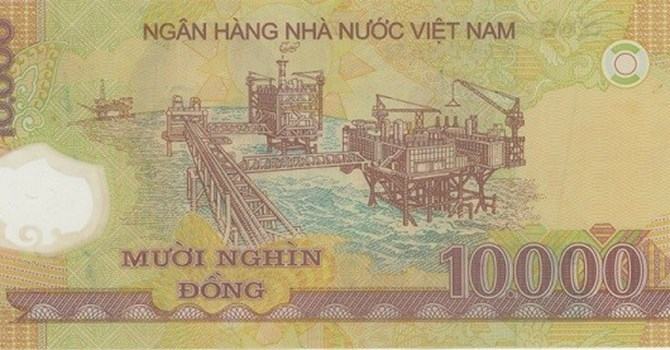
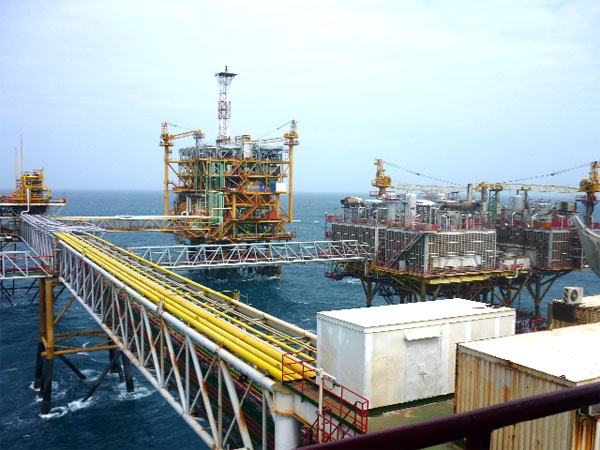
Covered Bridge, Hoi An (VND 20,000 bill)
Chua Bridge is an ancient bridge in the ancient urban area in Hoi An , Quang Nam province and is one of the bridges in Hoi An. Chua Cau – as the name suggests – is a temple located on a bridge over a small creek. Built in the early 17th century by Japanese merchants, this is the only work of Japanese origin in history. Hoi An Japanese Bridge is also another name for Bridge Pagoda. The image of Cau Pagoda is printed on the back of the VND 20,000 polymer bill. The Covered Bridge, Hoi An, was built with donations from Japanese merchants in the 17th century. Legend has it that the temple is believed to be a sword that pierced the back of the monster Namazu, preventing it from swinging. tail, causing earthquakes.
Appearing on a Vietnamese banknote with a denomination of 20,000 VND, Cau Pagoda (Hoi An, Quang Nam) is calm with ancient architecture. Built-in the 17th century. Then in 1653, the bridge was built with a pagoda, connected to the protruding railing in the middle, where people, merchants… burned incense to pray on every moon occasion. full moon, the first day. Since then, the local people have always named this place Chua Cau. From May 17, 2006, Chua Cau appeared on the 20,000 polymer banknote and was widely used. Chua Cau on the outside and on the banknote is not much different. If you come to Hoi AnIt would be a pity not to visit this place. The building is regularly monitored by local security forces and has a team of enthusiastic guides, always ready to provide more information for tourists.
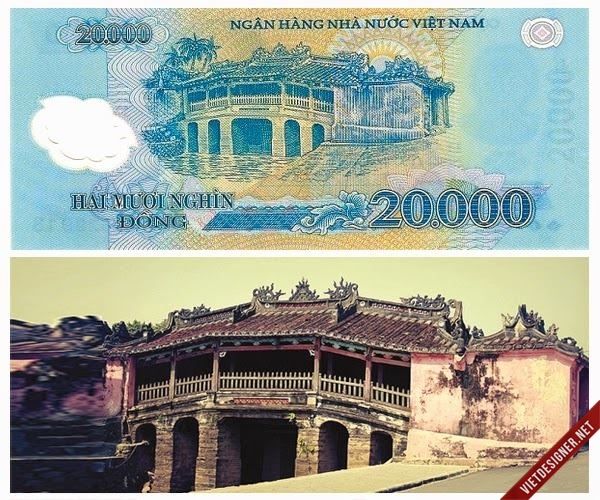
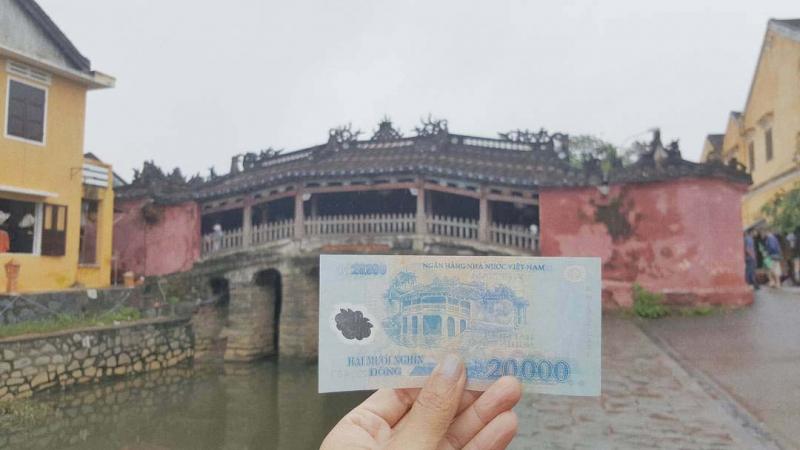
Nghinh Luong Dinh, Phu Van Lau (VND 50,000 bill)
Located on the banks of the romantic Perfume River of Hue, Nghinh Luong Dinh is a place for the king to enjoy the wind and admire the scenery. Nghinh Luong Ta is designed in the style of a family house with 1 compartment and 4 wings, both front and rear have extended crab shell houses. Not far away, Phu Van Lau, built under King Gia Long in 1819, is the place to list important edicts of the king and the court or the results of exams held by the court. Phu Van Lau is a two-story house, facing south. Phu Van LauToday in Phu Hoa ward, Hue city is an architectural work located in front of Ky Dai, also known as Hue Citadel. Under the Nguyen Dynasty, this work was the place to list the letters or the results of the competitions of the Dinh Competition. According to historical records, under King Gia Long, the court built a small communal house to hang a bulletin board called Bang Dinh. During the reign of King Minh Mang, Phu Van Lau became the place to publish important letters of the king.
This work is a 2-story building with a height of 11.67m. It is surrounded by a railing system and supported by 16 red-painted columns, including 4 strong main columns supporting both floors and 12 military columns. Upstairs has four sides erected puzzles, silk paintings with picture frames, the front has rectangular windows, round windows on both sides, wooden railings outside. On the façade window, there is a gilded screen with lacquered paint, decorated with stylized leaves “two dragons and moons”. The roof of the building is covered with yellow glazed pipe tiles. Up to now, Phu Van Lau and Nghenh Luong Dinh are two places that tourists come to visit and love because of the ancient beauty that combines Ky Dai and the poetic Huong Giang stream. As a work considered as one of the symbols of Hue Ancient Capital, Phu Van Lau’s image has been printed on the back of the VND 50,000 banknote issued by the State Bank of Vietnam since 2003.
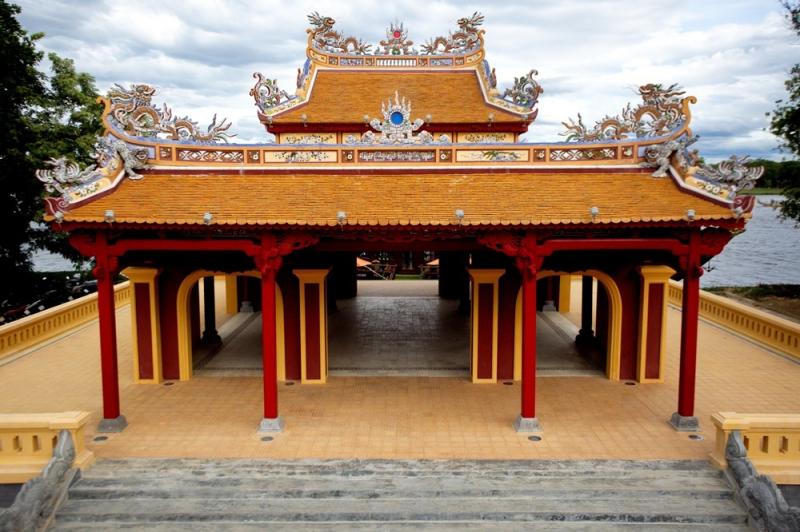
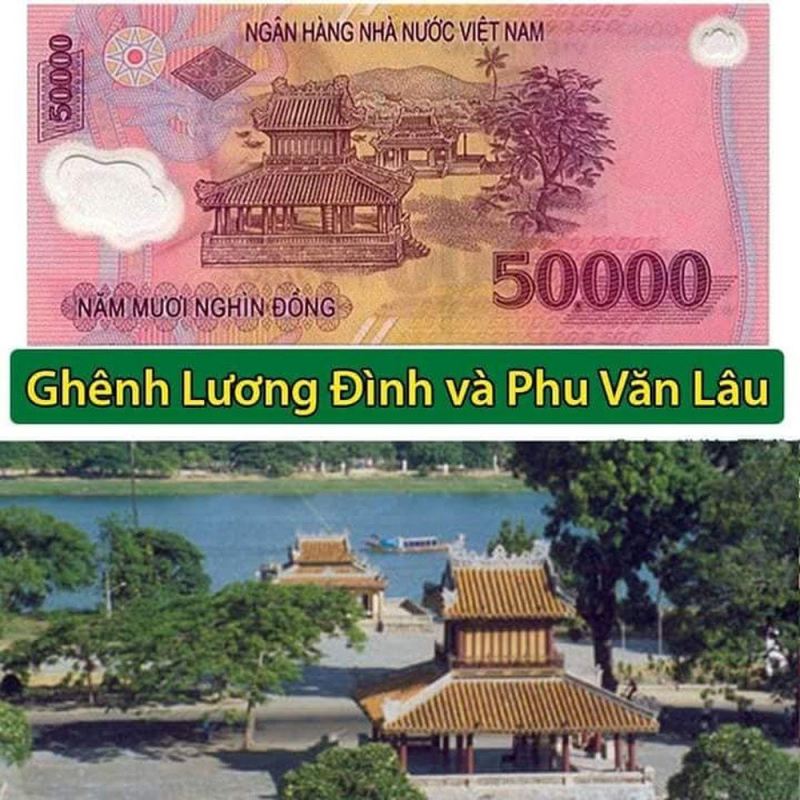
Temple of Literature Quoc Tu Giam (VND 100,000 polymer note)
The landscape of the Temple of Literature – Quoc Tu Giam (Hanoi) is pictured on the back of the 100,000 VND polymer banknote. Issued on September 1, 2004, this note has an overall color of dark green, measuring 144 mm x 65 mm. Temple of Literature – Quoc Tu Giam is a complex of 2 relics, in which Van Mieu is a place to worship Confucius, Confucian sages and “teacher of eternity” Chu Van An, and Quoc Tu Giam is a university. Vietnam’s first. Is a familiar destination for anyone when visiting Hanoi, but few people know the image of the Temple of Literatureprinted on a very popular polymer 100,000 dong note today. Temple of Literature – Quoc Tu Giam has been included in the list of 23 special national monuments by the Prime Minister of Vietnam. With more than 700 years of operation, having trained thousands of talents for the country, Quoc Tu Giam is considered as the first university of Vietnam and also a symbol of the feudal education of this country.
The Temple of Literature – Quoc Tu Giam is surrounded by brick walls, the interior is divided into 5 layers of space with different architectures. Each layer of space is limited by brick walls with a set of 3 doors to connect to each other (including a central door and two side doors). From the outside to the inside, there are two main gates to enter, respectively Van Mieu Mon and Dai Trung Mon. Today, Temple of Literature – Quoc Tu Giam is a place to visit for domestic and foreign tourists, as well as a place of commendation for excellent students and also a place to organize an annual poetry festival on the full moon day of the first month. This used to be the place where the students came “for good luck” before each exam by stroking the turtle’s head at the doctor’s stele. However, today, to preserve the relic, a fence was set up and the soldiers no longer performed the ritual of praying for good luck as before.
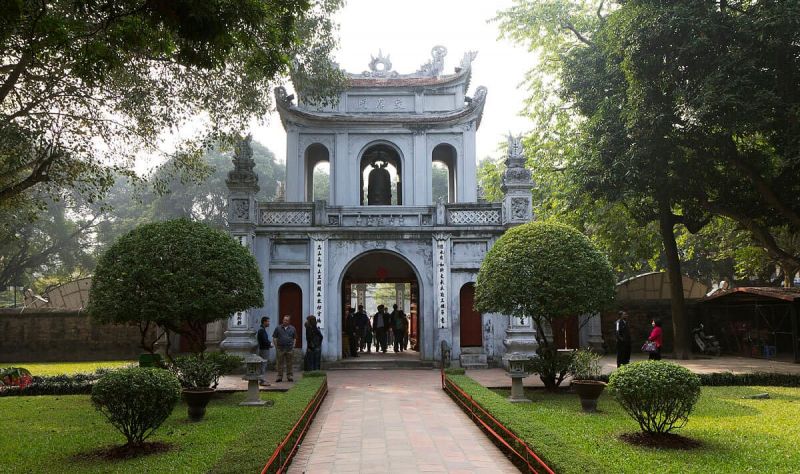
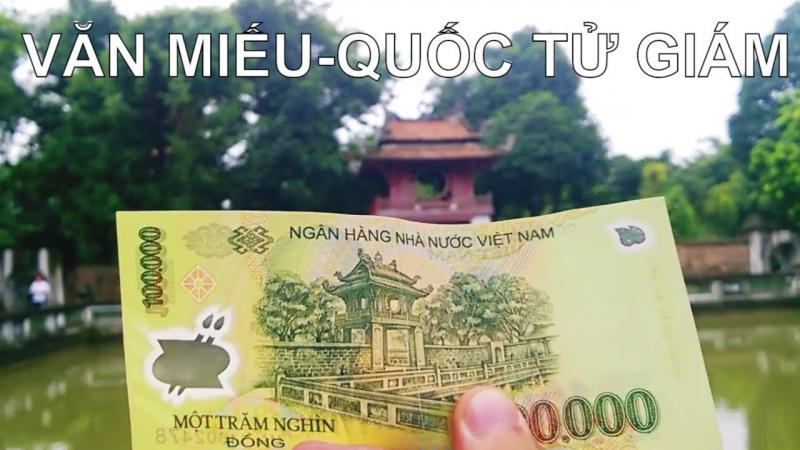
Ha Long Bay (VND 200,000 bill)
Ha Long Bay is a small bay on the west coast of the Gulf of Tonkin in the Northeastern Sea region of Vietnam, including the island waters of Ha Long city in Quang Ninh province. Being the center of a large area with more or less similar elements in geology, geomorphology, landscape, climate, and culture, with Bai Tu Long Bay in the northeast and Cat Ba Archipelago in the southwest, Ha Long Bay is limited to an area of about 1,553 km² including 1,969 large and small islands, most of which are limestone islands, in which the core area of the bay has an area of 335 km² with a dense cluster of 775 islands. The tectonic history of the bay’s limestone karst has spanned about 500 million years with very different paleo-geographical circumstances; and full karst evolution over 20 million years with a combination of factors such as thick limestone, hot and humid climate, and overall slow tectonic uplift.
The combination of environment, climate, geology, geomorphology, has made Ha Long Bay become the convergence of biodiversity including tropical moist evergreen closed forest ecosystem and marine and coastal ecosystems. shoreline with many sub-ecosystems. On the back of today’s VND 200,000 polymer note is the image of Dinh Huong Island in Ha Long Bay, Quang Ninh Province. Lu Huong Peak, also known as Dinh Huong Islet, is located southwest of Dau Go Cave. From Dog Stone Island to the seafood raft house, visitors will admire a large stone standing on two very slender legs that rise to block the path. The stone has the shape of a giant censer standing in the middle of the sea as a sacred offering to heaven and earth, reminding us of the tradition of drinking water, remembering the source, grateful to our ancestors and sages who had built build, and defend the country. Currently, Dinh Huong Island (Central of incense) is printed on the 200,000 VND bill, as a reminder of a meaningful image.
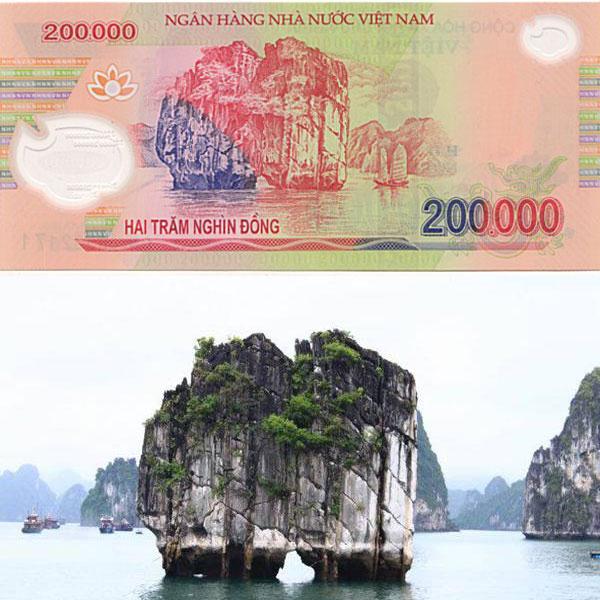
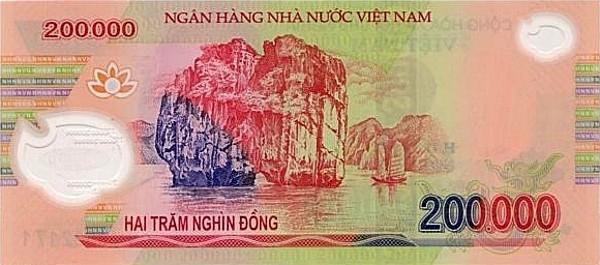
A 5-room house in Sen village, Nam Dan, Nghe An (VND 500,000 bill)
On the back of the 500,000 note is a picture of a 5-room house in Sen village, Nam Dan, Nghe An. This is the hometown of President Ho Chi Minh – where he lived from childhood until the age of 16. Is a place associated with President Ho Chi Minh in the countryside outside Hoang Tru village, Kim Lien commune, Nam Dan district, Nghe An province? Where President Ho lived in the years 1901 – 1906 in the countryside outside Kim Lien village; Hoang Thi Loan’s grave is President Ho Chi Minh’s mother. In general and many other monuments have been associated with Ho Chi Minh’s childhood. Sen village is located in Kim Lien commune, Nam Dan district, Nghe An province – the central land full of sunshine and wind. From Vinh city, follow Highway 46 about 15km to Sen village (Kim Lien village), Uncle Ho’s hometown. Though time has passed for a century, things change; The old images of Sen Village associated with Uncle Ho’s childhood are still preserved to this day as a beautiful memory and a shining example for future generations to come here.
It is a 5-room wooden house, thatched roof , small, rustic, simple under the green of the garden and the bamboo shadows. This is the main residence of the whole family, next to the house is used as a kitchen. Experiencing time with historical fluctuations and rain and sun, the house is of course not intact as it was originally. But in order to keep a great spiritual value, the house has been protected, preserved and restored to always exist in the homeland of Sen Village, in the minds of every Vietnamese. The historic cottage is the most important cluster of relics of Kim Lien Historic Site – built in the 60s of the last century, along with many other architectural items, upgraded and embellished many times.
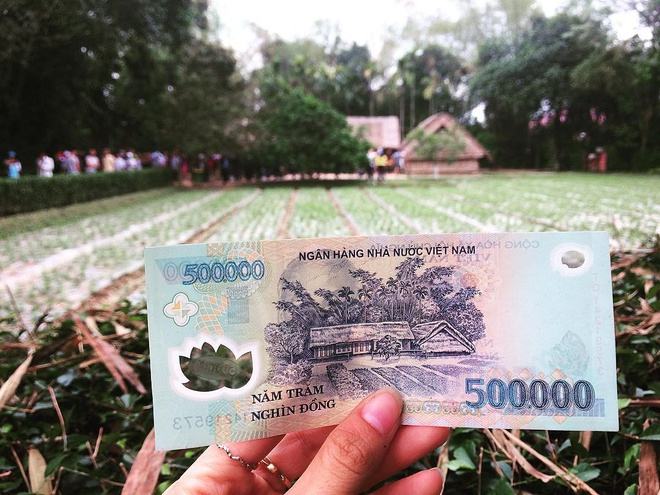
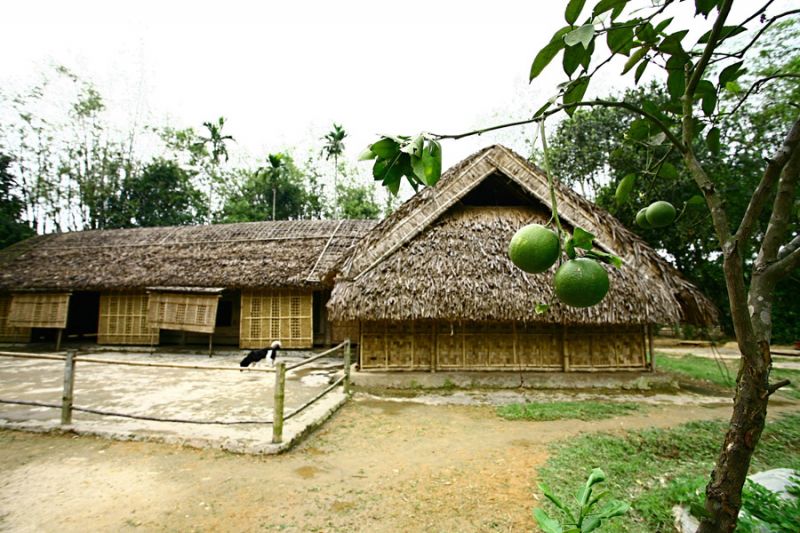
The places on the Vietnamese currency are historical relics, famous landscapes or works that attract visitors. Every day when you spend money, have you noticed that the banknotes we use contain images of places printed on Vietnamese coins? Try to pay attention to see interesting things about our country and people.
Photo: Internet
